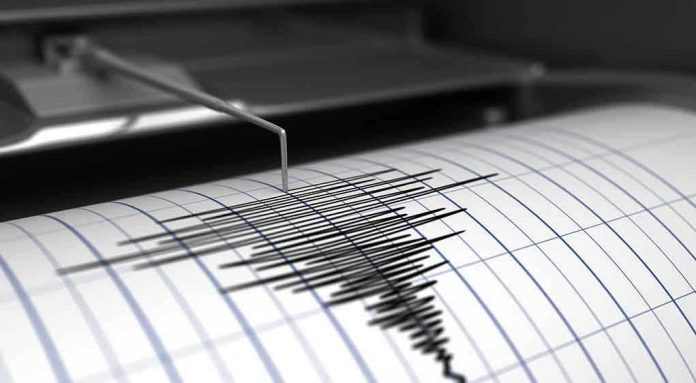
One violent minute beneath the Philippine Sea shattered homes, lives, and the illusion of safety for millions—yet the real story is what happened when the shaking stopped.
Story Snapshot
- A 6.9-magnitude earthquake struck Cebu Province, causing mass evacuations, building collapses, and power outages.
- At least five deaths confirmed, with more casualties feared as search and rescue operations continue.
- Tsunami fears triggered widespread panic in coastal communities and exposed ongoing vulnerabilities in regional infrastructure.
- Response efforts test the limits of local government preparedness and community resilience in a high-risk seismic zone.
When the Ground Gives Way: The Night Cebu Changed
Residents of Cebu, a bustling hub in the Central Visayas, felt the floor heave and the walls crack. With a magnitude of 6.9, this was no ordinary tremor. The earth’s violence did not discriminate. Concrete sports complexes, beloved churches, and busy fast-food restaurants alike crumbled or collapsed. A mall erupted in flames, and power grids flickered out into darkness. Within minutes, the fear of a tsunami sent entire coastal neighborhoods fleeing into the night, clutching children and whatever they could carry. The official death toll—five, as of the first morning—does not account for the trauma etched into those who survived.
As aftershocks rattled nerves and windows, the Philippine Institute of Volcanology and Seismology (PHIVOLCS) issued a tsunami advisory, urging vigilance in an archipelago painfully aware of nature’s double strikes. In Cebu and neighboring towns, the scenes replayed: collapsed walls, dazed survivors, and emergency sirens wailing through the chaos. Schools and government offices shuttered overnight. By dawn, local governments debated declaring states of calamity, facing a new day with the old question: Are we truly prepared for the next big one?
The Anatomy of Vulnerability: Why Cebu Was at Risk
Cebu sits atop the Pacific Ring of Fire, where the Eurasian and Philippine Sea plates grind and heave, scripting the region’s seismic fate. The Philippine Fault System, a 1,200-kilometer scar through the archipelago, has delivered disaster before—Bohol in 2013, Eastern Samar in 2019—each time exposing the fragility of both infrastructure and preparedness. In 2025, those lessons proved only partially learned. Urban density meant more lives at risk, while decades of inconsistent building code enforcement left critical structures exposed. The quake’s reach—felt by millions, disrupting power grids and supply lines far beyond the epicenter—underscored the interconnected fragility of modern life in a seismic hotspot.
8/
A fire broke out inside a mall in Consolacion town, northern Cebu, following the 6.7 magnitude earthquake on Sept 30, 2025. (lindol, sismo, deprem)Emergency response is ongoing as the fire adds to the extensive damage in Cebu, Philippines amid the recent quakes. pic.twitter.com/vJW4ANeo4B
— GeoTechWar (@geotechwar) September 30, 2025
Historical context matters here. Previous earthquakes prompted some upgrades, but retrofitting remains incomplete, especially in coastal towns where the most vulnerable often live in substandard housing. The region’s geography magnifies risk: low-lying coasts are not only in the bullseye for shaking but also for tsunamis, as this event’s brief sea-level disturbance proved. The result, once again, was a humanitarian crisis within hours—injuries, deaths, and a mass displacement of families whose lives will not return to normal soon.
Testing the System: Response, Recovery, and the Search for Accountability
PHIVOLCS acted swiftly, issuing bulletins and calming fears of further major aftershocks. Local governments swung into action: San Remigio’s mayor weighed a state of calamity, while disaster risk councils coordinated relief and search operations. The National Grid Corporation and Visayan Electric scrambled to restore power, their crews working by flashlight and generator. National agencies offered technical expertise and, if needed, funding. But as is so often the case, the first responders were neighbors—pulling survivors from rubble, sharing food, and comforting the shell-shocked in makeshift shelters.
Power dynamics revealed familiar patterns. Local authorities bore the brunt of public scrutiny, while national bodies set the narrative. Private utilities, under pressure to restore basic services, had to coordinate with overstretched government teams. Community organizations filled gaps, delivering aid where bureaucracy lagged. The stakes for all were stark: public trust, political survival, and, most importantly, the saving of lives in the critical first 72 hours. As search and rescue shifted to recovery, the question loomed—will this disaster finally spur lasting reforms, or will complacency set in once headlines fade?
Aftershocks for the Nation: What Comes Next?
The immediate aftermath saw loss, disruption, and anxiety. Families mourned, businesses shuttered, and children stayed home from closed schools. Economic losses rippled outward, with tourism and services, Cebu’s economic lifeblood, grinding to a halt. The insurance sector braced for claims, while engineers tallied up the cost of rebuilding. But the social and psychological toll—fear, uncertainty, and the all-too-familiar trauma of yet another disaster—may last longest. The quake’s legacy will include hard questions: Why do unsafe buildings persist? Can disaster-preparedness be more than a slogan? And what will it take to make resilience a real, lived experience for every Filipino?
Experts agree: geography alone cannot be blamed. Improved building codes and early warning systems matter only when implemented and enforced. Community preparedness—especially in coastal areas where tsunami risk compounds every quake—remains the linchpin. Ultimately, Cebu’s disaster is a call to action for policymakers, engineers, business leaders, and citizens alike. The days ahead will reveal whether the lessons of September 30, translate into meaningful change—or become another chapter in the country’s long history of natural tragedy and hard-earned resilience.
Sources:
2025 Cebu earthquake – Wikipedia
PHIVOLCS Official Earthquake Bulletin






